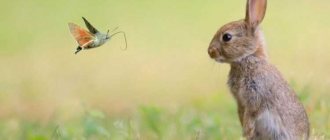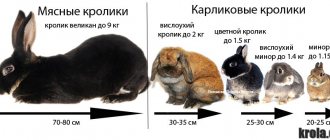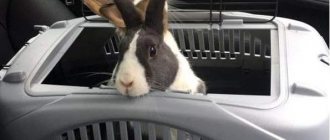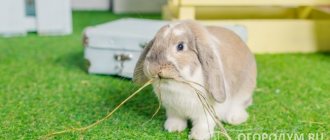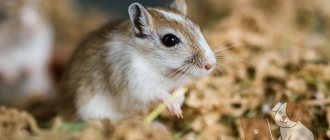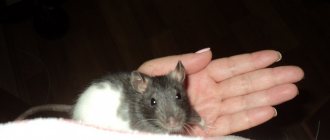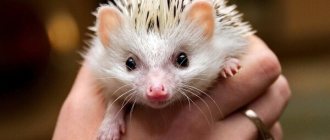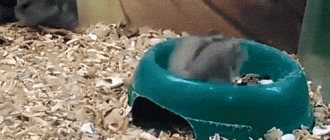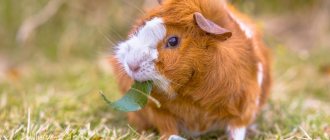The list of pets is not limited to cats, dogs and hamsters. No one is surprised by people with mini pigs on a leash, and many people have dwarf rabbits in their homes - cute animals that evoke universal affection with their appearance. The peculiarity of mini breeds is that they remain miniature even in adulthood, in contrast to decorative rabbits, which are no less attractive in appearance, but grow to industrial sizes.
What is the difference between a dwarf rabbit and a decorative one?
So that, as an adult, the rabbit does not surprise you with its size, you should ask the seller for a certificate
People often wonder: what is the difference between dwarf rabbits and decorative ones. First of all, these are the sizes. When ornamental animals grow up, they can become very large.
But in childhood, all rabbits are small, and it is difficult to independently distinguish a dwarf individual. To avoid mistakes, you need to ask the seller or breeder to present a certificate or show the parents of the future pet.
Vaccinations
A dwarf pet of any breed must be vaccinated against myxomatosis and hemorrhagic viral disease. Such vaccines can be administered in combination or as a single component. Rabbits are delicate animals that do not tolerate various infections well, so overdue vaccinations can contribute to the death of the ornamental animal. For vaccination, it is better to contact a qualified veterinarian who will determine the age of the pet, the need for medication and the next steps regarding the health of the rodent.
Breeds and general description
You will be surprised, but this is exactly what a dwarf ram looks like
When the decision to have a dwarf rabbit has been made, you need to decide on the choice of breed. Such animals are colored and white, and their weight ranges from 700 g to 3 kg.
The following breeds can be found in nurseries and pet stores:
- Dwarf ram;
- Dwarf rex;
- Foxy dwarf rabbit;
- Angora dwarf rabbit;
- Japanese dwarf rabbit;
- Dwarf hare;
- Dwarf rabbit Hermelin;
- Dutch dwarf rabbit.
Angora rabbits are particularly fluffy
Both the appearance and character of the animals depend on the purity of the breed. Some long-eared ones resemble a ball and are very peaceful, while others have rather short fur and a more aggressive character. So, first of all, the animal must evoke sympathy.
Colored dwarf
The breed was founded by the German breeder Hoffmann. By 1957, he had received a fairly large population of different colors: Marder, black, gray, Siamese, blue, etc. This breed is distributed throughout the world and is the most numerous.
Peculiarities:
- Weight: 1000-1500 g.
- Ears: 5.5 cm, straight.
- Coat type: medium.
- Any colour.
- How much does it cost: 3-7 tr.
The body of a colored dwarf has the shape of a cylinder. The front legs are short, the head is quite large, but short. The coat is shiny, medium length, thick. There should be no dewlap. Any color is allowed.
Pros and cons of content
Dwarf rabbits are affectionate and clean, but very susceptible to disease
There are advantages and disadvantages to owning these small, cute animals. Let's start with the pros:
- Cleanliness. Dwarf long-eared cats quickly become accustomed to the litter box, and there is very little litter from them in the apartment.
- These are affectionate, kind pets that immediately become attached to their owners. When they are happy, they click their teeth funny and make pleasant sounds.
- Rabbits are unpretentious in care and nutrition, and their maintenance is quite inexpensive.
The main disadvantage of animals is their pain. They can fall ill not only from infection, but also from sadness. Frequent visits to the veterinarian can take a lot of effort and time. Another disadvantage is the problem of constantly gnawing on something. Buying toys will help solve the problem: the rest of the things in the house will remain intact.
It is also worth considering that each rabbit, despite its small stature, is a personality. They are very touchy and remember bad treatment for a long time.
Smell
Many pet lovers often refuse to purchase a dwarf pet due to the problem of a strong unpleasant odor. But this factor can be eliminated by daily cleaning the animal’s cage, replacing the bedding, and also ventilating the room where the animal lives. It is recommended to castrate a male decorative rabbit so that he does not mark his territory with secretions with an unpleasant aroma. It is possible to train your pet to use a litter box, which is easy to clean like a cat. If, after completing all the steps, the smell persists, it is recommended to contact a veterinarian, as this may indicate a violation of the rabbit’s kidney function.
Care and maintenance at home
Keeping long-eared pets is not particularly difficult. It is important to choose a healthy animal and prepare a suitable room for it. It should be well ventilated, but without drafts. Heat is also contraindicated for rabbits; they cannot be placed near a radiator.
It is better to buy a cage with galvanized metal rods. Two males will not get along in it, but females or rabbits of different sexes can be placed together. Of course, the size of such a house should be larger.
Many breeders are afraid of unpleasant odors. If you properly care for animals, they will not exist. At the bottom of the cage, it is necessary to pour bedding from pieces of newspapers, sawdust or straw in time. These materials absorb odors well and can be quickly removed.
Long-eared dogs with thick hair need to be brushed regularly. In addition, approximately once every 3 weeks your pet needs to have its claws trimmed.
What to feed a dwarf rabbit
Dwarf rabbits can eat up to 30 times a day
Dwarf rabbits are big eaters: they eat up to 30 times per day. The owners must provide them with adequate nutrition and not restrict food, otherwise they can harm the digestive system. The food that the animal eats is quickly digested and reaches the intestines only after the next meal.
A pet's diet should be varied. It is better if it is based on ready-made balanced food from pet stores. You can also give hay. If the eared dog refuses to eat it, the hay is slightly moistened with water and salt.
The menu must be supplemented with grass, including meadow grass, as well as bone meal and chalk - a long-eared animal cannot do without minerals. It is useful to give oats or wheat soaked in water, fresh fruits and vegetables.
Important: You can give cabbage, which rabbits love, but red cabbage is contraindicated for them.
Sometimes rabbits eat the waste left in the cage. There is no need to be afraid of this: they are harmless to long-eared animals.
Hygiene and bathing
You should only bathe babies if they are very dirty.
Since dwarf rabbits are very clean, there is no need for regular bathing. But if the baby gets very dirty at home or on a walk, it is better not to let him clean himself, but still give him a bath. The rest of the time, you should not expose your baby to stress. He will take care of his own skin, which is also replaced with a new one every six months.
Diseases and treatment
Vaccines and vaccinations are necessary for dwarf rabbits. These gentle creatures, even in comfortable room conditions, can catch a disease such as a cold or conjunctivitis. Both hypothermia and heat stroke are equally dangerous for them. Timely vaccinations will protect rabbits from infections and dangerous diseases such as rabies.
Therefore, the condition of pets must be constantly monitored. The following symptoms may indicate the disease:
- Vomiting, nausea, bloating.
- Loose stools or constipation.
- Belching, rumbling in the stomach, bad breath.
- Fatigue, lethargy, drowsiness.
Even if there are one or two symptoms, the baby should be shown to the veterinarian: delay can be disastrous for him.
Vaccination
The smallest rabbits are protected from diseases by maternal immunity. When they switch to adult food, the body weakens. Vaccinations can begin as early as the sixth week. Animals are vaccinated against rabies, salmonellosis, listeriosis and some other diseases.
Before vaccination, you need to prepare: take care of the prevention of helminthic infestation, monitor the pet’s health, and stop bathing it a week before.
Selecting a cage and accessories
Take care in advance of entertainment for the rabbit in the cage
The dwarf rabbit is a delicate and fragile breed, which must be taken into account when choosing a cage. It is desirable that each individual has its own house. Its size must be 4–5 times the size of an adult rabbit so that the animal can move. It is advisable that its rods be made of unpainted iron: when the baby gnaws on them, his health will not suffer . It is better to choose a plastic pallet.
It is worth taking care in advance about purchasing accessories: tray, feeder, drinking bowl, toys. You also need to buy a manger into which hay will be poured. This is necessary because it quickly deteriorates on the floor.
Possible problems
In addition to the impressive list of advantages of keeping decorative rabbits, you need to familiarize yourself with the disadvantages, which, unfortunately, are many.
You need to take care of the cute little ears every day - trim their claws if necessary, comb their fur, and monitor their health.
If care is poor, an unpleasant odor begins to emanate from the cage or enclosure where rabbits live. And if you leave an animal alone for several days, even its fur will begin to smell stench.
The living area of decorative rabbits must be cleaned every day. But it is not always possible to devote enough time to this procedure.
Despite the fact that rabbits are loyal to furniture and corners, when free to roam in an apartment or house, they are capable of chewing through wires, easily accessible things, and also scratching wallpaper.
The molting period of decorative rabbits is considered one of the most difficult
The owner of the animals has to pay extra attention to the pet’s fur and comb it thoroughly. And then clean his territory and the area close to the enclosure from small hairs.
The dimensions of the cage for keeping decorative rabbits are of decent size; accordingly, the room for its placement should be spacious.
Despite the usual cute image, the character and behavior of many breeds of decorative rabbits is not soft.
They will not ask to be held; on the contrary, once in the owner’s arms, they may begin to kick, kick with their hind legs, and some even bite.
Mature decorative rabbits begin to mark their territory. They scatter waste from their own body throughout the enclosure, and after indoor walks the owner will have to clean the floors of feces. The smell from the rabbit will be appropriate, but only sterilization will help get rid of it. Another disadvantage is mandatory vaccination.
In general, keeping decorative fluffies with long ears is not difficult if a whole family lives in the house. It will not be easy to maintain them alone; a sufficient amount of time and effort is spent on them.
Breeding dwarf rabbits
When breeding rabbits, the key is moderation.
A feature of decorative rabbits is the possibility of early mating. They reach sexual maturity in 6–9 months. At this time, the animals are ready to reproduce. At one time, a female rabbit brings on average 5–7 babies. Breeding rabbits too often is not recommended, as this may affect the quality of the offspring.
How to determine the sex of an animal
Rabbits aged one to two months are practically indistinguishable from each other. The sex of animals can only be determined from documents. The genitals will help determine it externally. The animal must be placed with its belly up on its hind legs. After this, the tail is raised and the genital organ is gently squeezed. The male will have a penis, while the female will have a pink triangle.
Mating and pregnancy
Be prepared that a female rabbit ready for mating will dramatically change her behavior
It is best to breed a dwarf rabbit under the age of one year . When she is ready to breed, her character changes dramatically. The female becomes restless and irritable. At this time, it’s time to place her in the male’s cage, where she will become more docile. Mating occurs almost immediately. Then the animals need to be left alone for a while, and then seated. A day after this, control mating occurs.
Pregnancy in females lasts on average 31 days. If the litter is small and the offspring are large, it may last longer. When there are many rabbits, their mother will give birth faster.
During the first two weeks, the female's diet does not need to be changed. Starting from the third week, the dose should be increased slightly. The menu of the expectant mother should include fruits and vegetables, especially cucumbers: they are believed to enhance lactation. But you still shouldn’t overfeed your rabbit.
How to care for newborn dwarf rabbits
Rabbits are born deaf, blind and require special care. Their mother will look after them, and the owners must provide her with conditions and additional food. It is necessary to prepare a warm place for the offspring in advance: if the rabbits are placed on the floor, they will die.
There is no point in disturbing the rabbit again: she may get scared and harm the newborns. But you will have to make sure that she is always full and does not eat the babies. There is no need to worry that the female spends little time with the children. Unlike dogs and cats, rabbits do not sit with their offspring all the time, but only come to feed them.
Diseases
The most dangerous diseases for dwarf rabbits are myxomatosis, rabies and viral infections. In addition, animals often suffer from conjunctivitis and gastrointestinal disorders. Hypothermia or severe heat exposure is dangerous for delicate animals. The pet needs constant examination and attention, which will allow timely identification of the symptoms of the disease that has arisen and elimination of them with timely treatment.
Dwarf decorative rabbits are popular pets that bring joy to their owners and small children. Having decided to get this animal, you should choose the right breed that corresponds not only to your own desires and goals, but also to the possibilities of keeping it in the apartment. In addition, it is necessary to familiarize yourself with the biological characteristics of the pet, methods of caring for it, feeding habits of the rodent and possible difficulties in raising it.
Training and playing with your pet
Decorative rabbits just love to play
Dwarf rabbit breeds love to play and can learn some interesting tricks. They perceive training not as coercion, but as an opportunity to have fun. To achieve success, you need to eliminate negativity and aggression from the educational process. The best assistants in training will be praise and treating your pet with treats.
You should not start training your baby immediately after purchase. We need to give him a couple of months to adapt, after which he can begin training.
Feeding
The diet of dwarf decorative rabbits should contain a lot of fresh vegetables (carrots, cauliflower, broccoli, rutabaga, radishes, cucumbers), as well as fresh greens (dandelions, clover, cereal sprouts, nettles), dry fruits (bananas, papaya, pears, apples) and hay. Animals need to be fed about 2% (of total food) table salt. Animals can be given 1-2 tablespoons of granulated dry food per day. Pets also need vitamin supplements.
How to toilet train an animal
Accustoming a baby rabbit to a litter tray requires a lot of patience from the owner.
The little rabbit is gradually getting used to the toilet, but you will have to be a little patient. It is advisable to remember in which corner the breeder had the tray and place it there at home. It is worth asking the breeder for some used litter and mixing it with the old one. The pet will quickly find its native smell.
If the baby doesn't get into the tray, there's no need to swear. As soon as it becomes noticeable that your pet wants to go to the toilet, you must immediately put him in the litter tray. After a job done successfully, the animal should be praised. If you patiently train your pet to use the toilet day after day, the result will be achieved.
Satin dwarf
An American breed of rabbits with a special guard hair structure. It has a hollow shaft that reflects light well and gives the wool a unique shine. The first mutation occurred in 1934, after which these animals began to be purposefully bred.
Characteristic:
- Weight: 1500-2200 g.
- Ear length: 6-9 cm, straight.
- Wool: medium.
- Color: white, black, chocolate, red, chinchilla, Siamese, otter, opal.
- Price: 2-9 t.r.
A dwarf variety of satin rabbits was obtained not so long ago. Their body is slightly elongated, their back is rounded. The peculiarity of satin rabbits is their shining and iridescent fur, thanks to which it is impossible to confuse these animals with other breeds.
What to name a dwarf rabbit
Choosing a name for these affectionate creatures is not an easy task, because you want your pet to have the most beautiful one. At home, rabbits are called completely differently than on farms.
The name has a certain influence on the character of the pet. A rabbit whose nickname sounds soft has a more docile character than an animal with a harsh name. When choosing, you can take into account body type, color, and other appearance features.
For boys, the names Coal, Ryzhik, and Donut may be suitable. Popular rabbit names are Yasha, Fomka, Stepan. Female rabbits readily respond to the nicknames Bunny, Smokey, Pushinka. Girls with a proud, unapproachable character are given names such as Eva, Gerda, Magnolia.
To quickly accustom your baby to his name, you need to call him as often as possible . If the name is sonorous and short, there will be no problems.
Colored dwarf Dutch
A breed that was obtained in the Netherlands. It was officially recognized in 1940. To obtain it, they used hermelins and local small rabbits. Such animals appeared in Russia in 2013.
Characteristic:
- Weight: 800-1300 g.
- Ear length: 5-7.5 cm, straight.
- Wool: medium.
- Color: any.
- Price: 2-7 t.r.
Small rabbits whose weight should not exceed 1300 grams. The head has a rounded shape. The muzzle is wide, the eyes are round and large. The ears are located close to each other. The limbs are short and adjacent to the body.
Growth rate
Changes in little rat pups are observed daily:
- On the 3rd day the ears appear.
- Teeth appear on days 8-10.
- After 2 weeks, the nipples of females become visible.
- In the third week, the eyes open and the body becomes covered with fur.
The period of childhood in animals is very short, which is confirmed by the following:
- Within 10 days, the pups grow to the size of an adult mouse.
- After a little more than three weeks, the animals begin to feed on their own.
- After 30 days, the cubs leave the parental nest.
Subsequently, the rats grow until the age of 6 months. After this, they gradually mature and reach their maximum size at about a year.
Mini lop lionhead
These animals were obtained in England in the early 2000s, but they are not yet officially recognized. The best representatives of the lion-headed dwarf and mini lop breeds were used for breeding.
Peculiarities:
- Weight: 1500-1600 g.
- Ears: 21-25 cm, hanging.
- Coat length: medium, long in the head area (up to 7.5 cm).
- Any colour.
- Cost: 6-13 tr.
These animals are quite miniature. A characteristic feature of the breed is a very thick mane on the head, while the hair on the body is short (no more than 2 cm). The body is dense, strong, the back is rounded. Lion-headed mini-lops have a round head proportional to the body.
Minilop
Minilop is a lop-eared rabbit. However, this breed's ears do not droop as much as those of Lambs. Babies are very reminiscent of a plush toy. The breed is quite difficult to breed. It is lightweight - up to 1.3 kilograms. The body of rabbits is quite massive, the head from the side looks like a ball. The color can be varied, the wool is thick and thick. Minilops are very playful and friendly animals, so they are quite popular among lovers of such animals.
Lion-headed individuals got their name for the specific growth of their fur.
Hotot
A small white rabbit with a black border around the eyes. The weight of this baby is a little more than 1 kg. The ears are small, up to 7 cm long. The fur is soft and pleasant to the touch.
These pets are very cheerful, they need to exercise a lot, and they are always happy to play with their owner. Hotots are smart animals and, with proper training, are capable of following simple commands.
King of the Giants Ralph
There are also real eared giants. Their weight exceeds 10 kg, and their body length is more than 1 m.
The largest rabbit in the world now is a pet named Ralph. He is a Guinness Book of Records champion. Its weight reaches 23 kg. Ralph's parents were also record holders.
Before Ralph, this honorary title belonged to a giant rabbit named Darius, whose weight was 19 kg with a body length of 120 cm. He eats a couple of heads of cabbage a day, carrots and apples, and also loves bread and corn.
This rabbit is comparable in weight to a 3-4 year old child.
